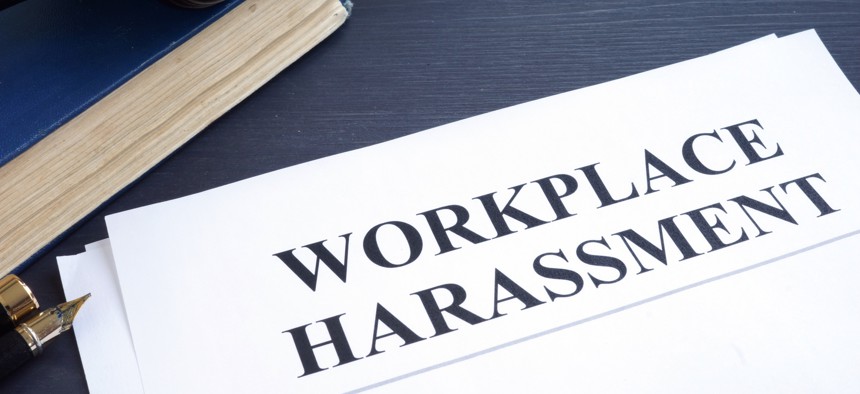
GAO officials said that while seven DOD components and six other federal agencies conduct harassment training, they often don't have methods to determine their effectiveness. designer491 / GETTY IMAGES
Agencies need to beef up sexual harassment training for employees, GAO says
Selected federal agencies and components of the Defense Department have only partially implemented an array of training practices aimed at preventing sexual harassment and do not sufficiently evaluate the effectiveness of their existing training programs, the watchdog found.
A government watchdog agency has found key gaps in federal agencies’ support to training programs aimed at preventing incidents of sexual harassment in the workplace.
Federal agencies are required to address incidents of sexual harassment both via complaints before the Equal Employment Opportunity Commission and their own internal investigation enforcement programs, and they are required to provide training to employees on sexual harassment at least biennially. A 2021 survey by the Merit Systems Protection Board of nearly 4,200 federal workers found that 12.6% of respondents reported that they had experienced sexual harassment in the workplace within the last two years.
A Government Accountability Office report published Monday found that select federal agencies and Defense Department components frequently have only partially implemented an array of best practices relating to sexual harassment training, and few if any of those agencies surveyed routinely evaluate the effectiveness of existing training.
“All seven DOD components and six other federal agencies require their employees to complete some sexual harassment prevention training,” GAO wrote. “However, none of them have fully incorporated GAO and EEOC management practices to enhance the effectiveness of their training content and the implementation of such training. They also do not know if their training needs improvements because they have not developed and implemented plans to evaluate its effectiveness.”
Along with the Defense Department, GAO evaluated the harassment training programs of the Interior and State departments, General Services Administration, Federal Deposit Insurance Corporation, Security and Exchange Commission and the Environmental Protection Agency.
While the agencies and Defense Department subcomponents all reported some compliance with the need to revise and update training when needed to implement new laws or policies, other elements of successful harassment prevention training programs have been implemented more sporadically, GAO found.
“All seven DOD components at least partially incorporated the practice of revising and updating training as needed, but officials from only one component stated that a portion of its training was developed using social science research on harassment and retaliation—a practice designed to help ensure relevant and effective content,” the report stated. “[Similar] to what we found with the DOD components, all six agencies at least partially incorporated the practice of revising and updating training as needed. However, none of the agencies incorporated the practice of conducting training in smaller groups to foster more employee engagement and participation.”
But the chief problem with the agencies’ harassment prevention training is their failure to routinely evaluate the effectiveness of training, GAO found.
“Training evaluation can identify and highlight emerging and best practices, which in turn can help develop employees and improve agency performance,” GAO wrote. “Furthermore, data collection and analysis plans can guide agencies in assessing the effectiveness and efficiency of training by outlining clear goals about what the training is expected to achieve and agreed-upon measures to ascertain progress toward those goals . . . Evaluation is essential for organizations to know how well training is working and consider how it might be improved.”
But the agencies surveyed in the report cited difficulty measuring training’s effectiveness and a lack of resources to devote to evaluation and revision of existing training programs. And officials at EPA suggested that evaluating its training program was unnecessary because sexual harassment is “not pervasive” at the agency, an argument GAO discounted due to the fact that instances of sexual harassment often go unreported.
GAO issued recommendations to each agency and Defense Department component to develop and implement plans to evaluate their existing sexual harassment prevention training programs for potential deficiencies, along with an additional recommendation to the Pentagon’s Office of Diversity, Equity and Inclusion and undersecretary for personnel and readiness to develop a plan to better oversee the training programs of department components. Each agency cited in the report agreed with its applicable recommendation, though Defense Department officials only partially concurred with the final recommendation.
“DOD also noted that it partially concurred with [the last] recommendation because the Office of the Under Secretary of Defense for Personnel and Readiness’ oversight responsibilities pertain to DOD sexual harassment prevention policy, not implementation of workforce training, which is a responsibility of the DOD components,” GAO wrote. “[As] noted in our report, our recommendation is specifically focused on the development and implementation of a plan to facilitate ODEI’s execution of its oversight responsibilities relative to the components’ sexual harassment prevention training. The recommendation does not address the implementation of this training.”







